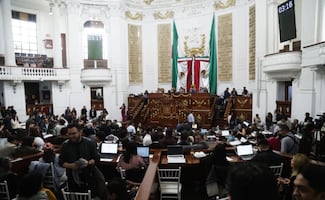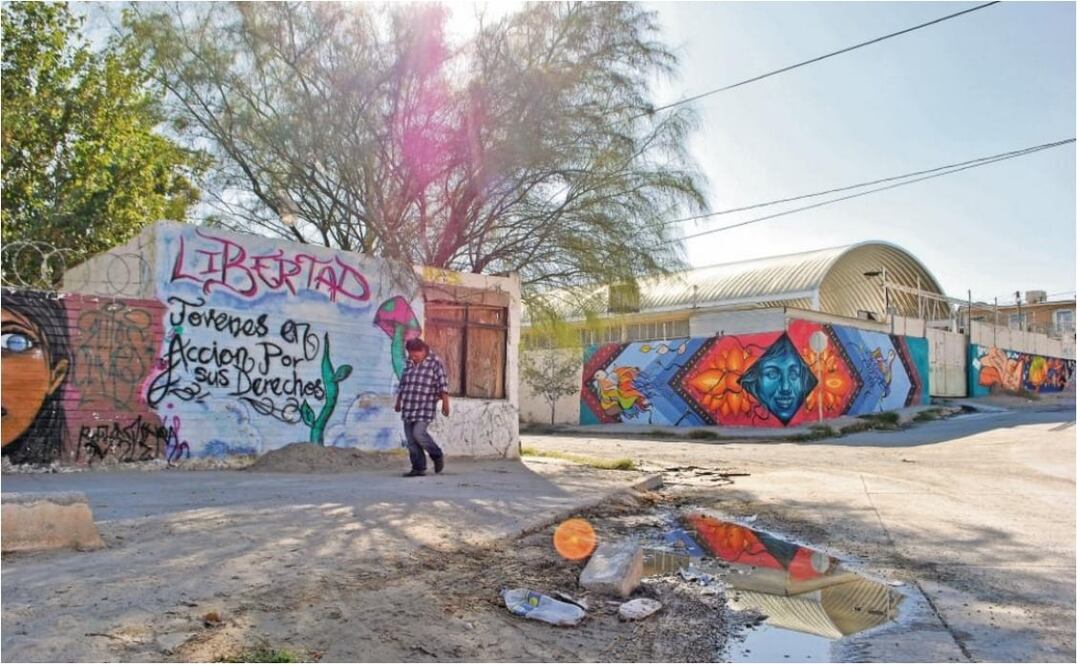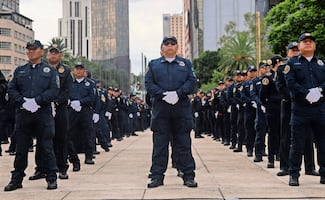Más Información

Congreso capitalino aprueba reformas contra violencia de género y familiar; endurecen penas y algunos delitos se perseguirán de oficio

Sheinbaum promete más seguridad en Chihuahua, Sinaloa y Durango; restituye 3 mil hectáreas de tierra a pueblos indígenas

Previo a marcha de la Generación Z, Fox pide a la ciudadanía que se involucre; "México no está cansado, está despierto", dice

Exgobernador César Duarte comparece en el Altiplano; jueza decidirá vinculación a proceso por lavado de dinero
On the corner of Madison and Pulaski in Chicago's West Side, next to a Church's Chicken, a young male shows up about every 30 minutes with a cell phone in one hand and the other hand in his pocket.
An anonymous drug user and buyer tells EL UNIVERSAL that he had never seen the man make that many stops at the corner like he has this year. Someone calls the man about every 30 minutes, he walks to the corner and hands them a small plastic bag with about 1 gram of heroin, which runs on the streets of Chicago for about 20 dollars. According to the Chicago Police Department, dealers make between 20 and 30 dollars for every five bags of heroin that they sell on the street, which today mainly comes from Mexico.
The anonymous buyer tells us that “everyone is using it now, even people who you'd never expect to use it before.”
According to the DEA, five Mexican cartels (the Sinaloa Cartel, the Juárez Cartel, Guerreros Unidos, Jalisco Nueva Generación and Los Zetas) now control over 50% of the heroin market in the U.S. alone as of last year, which is now a whopping 13.5 billion dollar industry.
This boom in market share and the cartels' ongoing battle for greater control is having serious consequences on the other side of the border. Ciudad Juárez, one of the most important routes for the traffic of heroin into the U.S., is being undermined by the drug.
Local activists claim that the demand for the drug in the U.S. has caused a massive spike in heroin addicts in Ciudad Juárez, something that had never been seen before in the city.
“Ever since demand in the U.S. went up, we're now seeing more and more users here on this side of the border” said an ex-addict with first-hand experience in the recent epidemic.
Civil organizations have noticed these changes and say that five years ago demand for heroin on the Mexican side of the border was virtually non-existent. There was no market for the cartels, but heroin addiction has since become so common that in such a short amount of time there is already an ongoing battle for control of the city's market.
Ciudad Juárez now has the highest number of heroin addicts per capita in the entire country, according to Centro de Integración Juvenil de Chihuahua, a government drug rehabilitation center.
Mapping heorin's distribution
Alex receives only two types of people in his home: addicts and suppliers. His job is to be there 24 hours a day, 7 days a week. He has a personal cell phone and one exclusively for work and he never takes a day off.
When Ciudad Juárez was declared the most violent city in the entire world after registering 3,100 homicides in a single year, not only did authorities drastically change their patrol strategies, but so did the cartels. Gone are the points of sales that cartels once used to sell their drugs, which were basically large homes used to store, cut, distribute and sell drugs.
Today, dealers use one of two techniques: cell phones or points of supply. In the first technique, cell phones, sellers in Ciudad Juárez basically get new customers by word of mouth, which is the same technique used in the streets of Chicago. Alex says this strategy is less risky, but sellers end up having to travel throughout the city all the time, and many don't like that. This is why he, and many others, are turning to the second technique: acting as points of supply. Here, sellers deliver between 10 and 20 hits of heroin, and only after selling that do suppliers supply them with another load. As a result, dealers no longer risk losing millions of dollars in merchandise after a government drug raid.
The cartels, besides change their sales and supply strategies, have formed new power structures for the purchase and sale of drugs. At the bottom of chain are armed safe keepers who are in charge of protecting supplies and keeping track of the authorities' and rival cartels' movements. Next up are dealers, like Alex, who are in charge of selling the drug and collection the money. Then are suppliers, who make sure dealers have enough drugs to sell to users and above them are processors, who oversee the processing, cutting, packaging and pressing of the drug. And finally at the top of the power structure are the traffickers, who make deals to buy and sell drugs by the kilo or ton.
This power structure applies in the entire city and according to local police authorities, most “hot spots” are in the city's downtown area.
Before heroin addicts ever existed
El Calambres (which translates literally as the Muscle Cramps) is repeatedly referred to as human waste. Leaders of El Barrio Azteca, an El Paso based Mexican-American gang, treat him like a dog, slap him around him and make him beg for basically everything. This baffled me at first, but it quickly became obvious, as we hid from the State Police in a neighborhood in Ciudad Juarez's downtown, that El Calambres desperately needed his fix of heroin, but he didn't have the 60 pesos (around US$3.50) to pay for it, and the Barrio Azteca took advantage of this. One of them says that addicts are worse than trash. “They're zombies,” he says. For leaders of the gang, addicts are their source of income. They don't see them as human, they see them as nothing more than disposable, replaceable things.
Members of local NGO's remember the 90s. They say only 20 years ago, if you were to walk down these same hallways, you'd see a completely different picture. You wouldn't see a single heroin addict and you'd never see anyone like El Calambres. “There was definitely heroin in the 90s, but you only saw it in El Paso, Texas. Heroin only passed through Ciudad Juárez, nobody actually used it here. Anyone who actually did use it had to cross the border and pay 20 dollars for a single hit of heroin,” we were told.
Today, on the Mexican side of the border, a hit of heroin runs for 60 pesos and the flow of addicts his literally taken an 180. Now you see hundreds of Americans from New Mexico and Texas who cross into Ciudad Juárez to buy the drug as cheap as possible. Local authorities say supply of the drug has skyrocketed in Ciudad Juárez and the price has dropped considerably.
A leader of the Barrio Azteca tells us that “addicts from the U.S. cross the border to buy between 10 and 20 hits of heroin in Ciudad Juárez and then go directly back home.”
In addition, activists claim that the heroin that's sold on the Mexican side of the border is of “extremely low quality,” and the drug that's sent to the U.S. is pure, which is only making matters worse.
According to the DEA, in 2003, 90% of heroin sold in the U.S. was from Colombia. However, in less than a decade, Colombia's market share of heroin was down to 55%, and of last year it's down to about 50%. For 2016, Mexican cartels are expected to control 60% of the market by year end.
Health officials have reported a 20% spike in heroin overdoses, and furthermore, according to activists, teenagers are the most vulnerable to becoming addicted to the drug: “we've noticed that teenagers 15 and up are the ones that are using it the most.”
Heroin's journey from Ciudad Juárez to Chicago
22 year-old Ignacio Nieblas and 19 year-old Bryan Márquez Flores, both from the U.S., were reported as being arrested this year in New Mexico near the border with Ciudad Juárez for possession of over five kilos of heroin. In a separate incident but in the same area, 53 year-old José Alfredo Alaniz, was arrested in the U.S. for possession of nearly 200,000 dollars worth of heroin. In July, a dozen U.S. and Mexican citizens were arrested in the same exact area by U.S. federal police agents and were charged with running a heroin trafficking network.
The most popular heroin network runs through Ciudad Juárez; El Paso, Texas; Sunland Park, Phoenix; and finishes in Chicago. Not only is this the most popular route, but these cities are also key markets for sale of heroin, according to the DEA's 2015 Drug Threat Assessment report, which analyzes trends in heroin use and trafficking.
Once in Chicago, the Sinaloa Cartel dominates the market. According to ICE, the El-Paso-Juárez international border has the highest volume of heroin traffic. In 2015, 8,237 ounces of heroin were seized in that border alone, out of 8,282 ounces of total heroin seized in all of the U.S.'s border. In other words, virtually 100% of heroin seized in 2015 crossed through that border.
None of these facts surprise the addict we interviewed in Chicago. “At the end of the day, the U.S. government created this problem, and now they claim to be worried; bunch of hypocrites.”
In a bizarre way, what he says isn't actually that far from the truth. According to findings by the U.S.'s Center for Disease Control as reported in their 2015 annual report, medical professionals, with the help of insurance companies, prescribed, without any control or oversight whatsoever, industrial strength opioides, such as Vicodin, to millions upon millions of patients in the U.S., which has contributed to a massive rise in the number of addicts. According to the Center for Disease Control, thousands of these addicts have since turned to heroin to satisfy their addiction. That's where the Mexican Cartels come into the picture, who since met the new demand for this drug.
Today, according to the U.S. Health Department, there are over one million U.S. Americans who are addicted to heroin and there's absolutely no end in sight to these escalating epidemic.
Noticias según tus intereses
[Publicidad]
[Publicidad]








